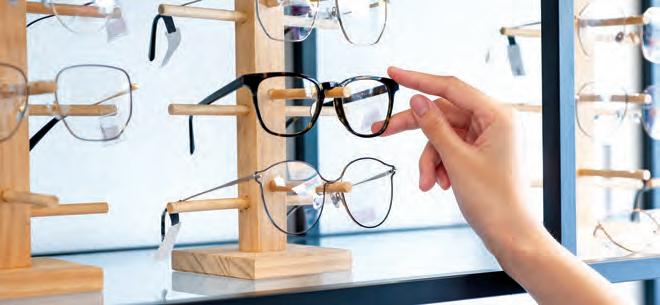
4 minute read
OPTICAL DISPENSING
from INSIGHT MARCH 2022
by Prime Group
HOW VITAL ARE QUALIFIED OPTICAL DISPENSERS?
MANY DISPENSERS DON’T REALISE THE VALUE THEY CAN BRING TO AN OPTICAL PRACTICE, STIFLING THEIR CAREER GROWTH. IN PART ONE OF HIS SERIES, STEVEN DARAS EXPLAINS WHY THEY’RE THE BUSINESS’ POWERHOUSE.
STEVEN DARAS
"OPTICAL DISPENSERS SHOULD START TO SHOWCASE THEIR KNOWLEDGE, TALENT, AND IMPORTANCE TO THEIR EMPLOYERS" Optical dispensing has been around in some form since the first spectacles were made. The science of optometry includes optical dispensing, so it’s always been a part of vision correction. In Australia, education for optical dispensing began circa 1954 and at a similar time, optometry moved from being taught at various technical and private colleges to university study.
Previously, qualified optical dispensers were registered/licensed in only some jurisdictions. This meant people couldn’t move interstate to work unless they were registered. The Federal Government wanting ‘a level playing field’ reduced this to the lowest common denominator by removing registration allowing people to work across borders.
Thus, there are many people who call themselves ‘optical dispensers,’ but aren’t actually qualified. They are usually taught in-house but due to their busy workplaces may have little time for quality teaching. In lower prescriptions, selling a pair of glasses is relatively easy.
However, in higher prescriptions this is harder. They may not be able to recognise potential problems due the eye’s condition or the prescription itself. Problems that aren’t recognised and avoided often lead to people having issues with their glasses that can lead to complaints, refunds or not wearing them. Not a good result for anyone involved.
Qualified optical dispensers learn about the eye, lenses, frames and how they combine to improve vision. They recognise ocular conditions and potential problems that may impact the prescription, taking steps to avoid these. They offer the best options to the wearer.
Optical dispensers don’t realise their importance to the industry – and from a business perspective they’re a powerhouse. Look at any successful optical business in Australia from large to smaller optical chains, buying groups, independent practitioners etc., and the bulk of their business comes from optical dispensing.
Optometry and optical dispensing must work side-by-side to realise this potential. Some optometrists don’t see it, thinking the consultation is more important when, in fact, dispensing is just as important from a quality practice and financial point of view. It’s like asking if the chicken or egg came first? Change that to ask, what’s more important, the eye test or dispensing the prescription? The answer to this is both; a successful practice can’t have one without the other.
Major optical chains and other practices don’t build empires from dollars generated by optometry fees; they build them from the dollars generated through optical dispensing. From small private practices to big optical retailers, it’s the selling of spectacle frames, ophthalmic lenses and treatments that brings in the most money. A good dispensing team will help build and support a thriving practice.
Hypothetical example: a new practice opens and in the first week 100 people have been booked for a bulk-billed test at $60 per person. During that week 40 spectacles are dispensed in-house. These vary from single vision ($100) to progressives ($800) at an average price of $400. • Optometrist – 100 tests @ $60 generates $6,000 • Optical dispenser – 40 spectacles @ $400 generates $16,000
The dispensing brings in more money, so makes a significant contribution to the success of that start-up company. Yet most optical dispensers don’t realise this and have allowed themselves to be relegated to a bit role, or that of salesperson.
This suits employers as they can pay lower wages. There’s also potential for employer-backed advocacy groups – representing ‘thousands of members (staff)’ – to set up and have a voice with government to keep wages static. Optical dispensers have been herded towards the retail path for years and this will help to keep them in check.
Unfortunately, many dispensers have only themselves to blame as they don’t apply their knowledge to give good advice and create dispensing plans to increase business, showing the boss their importance. Instead, most take the easy option and just sell glasses following a sales pattern.
Optical dispensers should start to showcase their knowledge, talent, and importance to their employers. They can do this by offering quality optical dispensing advice by educating their clients to the variety of visual requirements they have and matching them to the huge range of optical products available through Australia’s optical wholesalers (ODMA et al) who bring the world’s best optics to their door.
Hopefully, this brings recognition, promotion, and rewards from a grateful employer. n
It’s the selling of spectacle frames, ophthalmic lenses and treatments that generate the most revenue for practices.
ABOUT THE AUTHOR: STEVEN DARAS is Course Coordinator of Optical Dispensing TAFE Digital, co-author of the Practical Optical Dispensing and Practical Optical Workshop textbooks, a popular
conference speaker and a director and secretary of ADOA.






